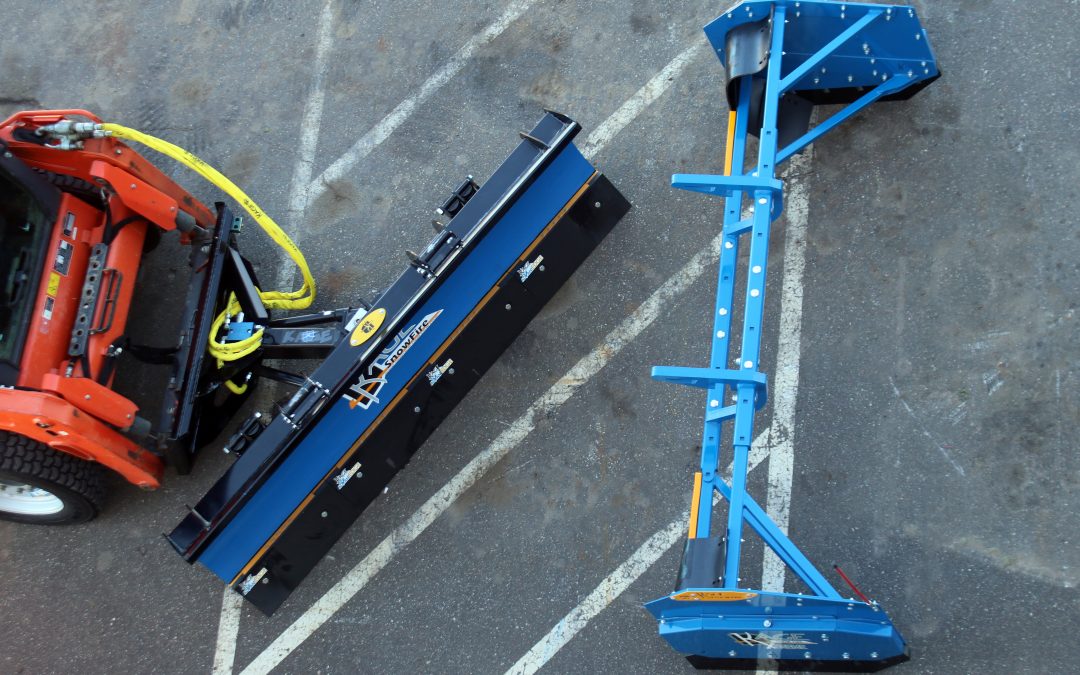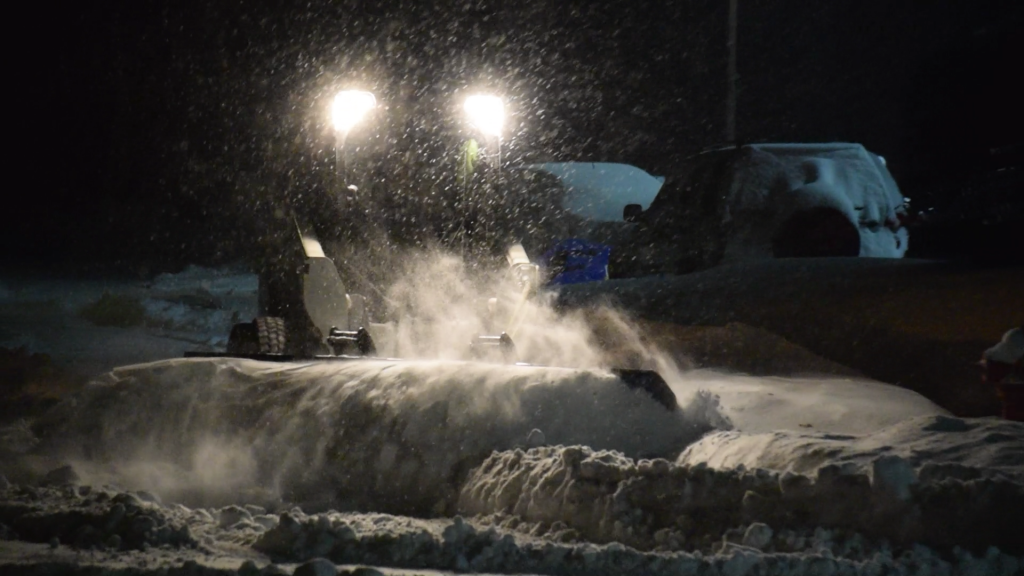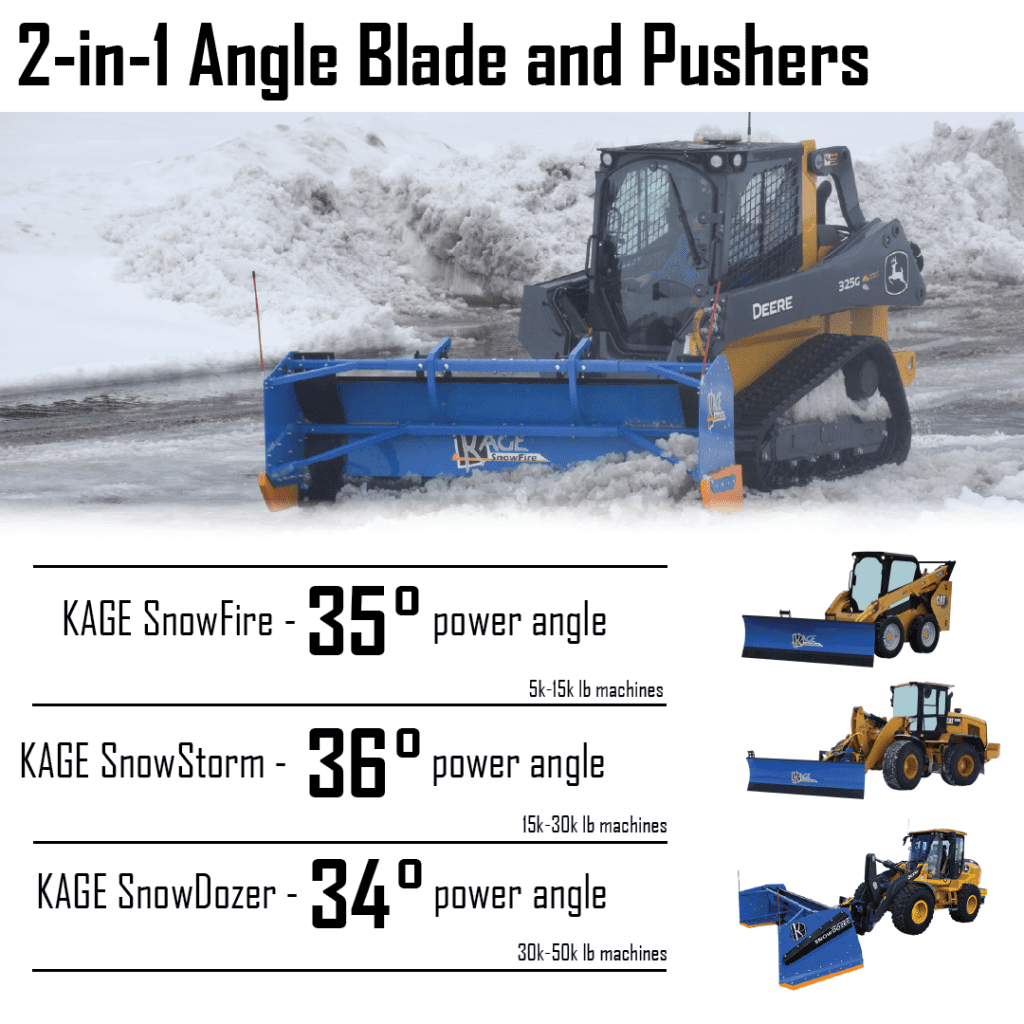When snow removal pros talk about “angle plowing,” they’re describing a fundamental way of moving snow: instead of pushing snow straight ahead, the blade is rotated (angled) left or right so the snow rolls off to the side. Angle plowing is simple in concept but powerful in practice — it changes how snow is directed, how much resistance the machine feels, and how cleanly pavement gets scraped. Below I’ll explain what angle plowing is, why different angles are used, why on-the-fly adjustability matters, and how KAGE’s snow-plow lineup pushes industry limits on angle range and attack geometry.
What angle plowing actually is
Think of a straight blade sitting perpendicular to the direction of travel: it pushes snow forward. Now pivot that blade a few degrees to the left — the blade becomes a ramp that directs the snow to the left side as you move forward. That pivot is the plow angle. Operators can set small angles for gentle redirection or steep angles for aggressive rolling and windrowing.
Why different plow angles are useful
Different tasks call for different angles. Here are the common goals and the angles that help achieve them:
-
Windrowing and side-throwing: Larger angles (often in the 25–36° range) direct snow quickly off a driving line into a neat windrow or off a curb. This is ideal when clearing parking lots or creating space between lanes. (KAGE plows are designed to reach well into this range — more below.)
-
Scraping and clearing to pavement: Attack geometry (how the cutting edge meets the surface) and moderate angling let you scrape down to asphalt without excessive drag. KAGE designs combine a steep attack angle with options for angling to maximize scraping.
-
Controlling machine load / reducing resistance: A properly chosen angle reduces the amount of snow resistance on the machine. Instead of trying to lift or push a big mass straight ahead, angling slices and funnels the load to the side so the machine can maintain momentum and traction. This comes in handy with wet, heavy snow.
-
Maneuvering tight areas: Smaller, incremental angles (and the ability to change them quickly) let operators steer snow around obstacles like curbs, islands, or parked vehicles without losing control of the pile.
Why “on-the-fly” angle adjustment matters
There’s a big difference between a plow you have to stop and mechanically reconfigure, and a plow whose angle you can change hydraulically from the cab while moving. On-the-fly angle adjustment matters because:
-
Speed and efficiency: You don’t stop work to change the blade. That’s dozens of small delays saved over the course of a shift — and those seconds add up into real productivity gains. KAGE highlights the productivity benefits of powered angle blades for pushing and maneuvering snow.
-
Safety and control: Changing ground conditions and obstacles appear instantly while you’re working. Being able to adjust the angle immediately reduces risky repositioning and awkward back-and-forth maneuvers.
-
Versatility: A single attachment can function as a straight blade, an angle blade, or a containment plow/box when it’s convertible — so operators can adapt to different job types without swapping equipment. KAGE’s 2-in-1 systems and wing plows are built around that idea.
The numbers: KAGE’s angle ranges and how they lead the industry
If you want specifics, KAGE’s product family demonstrates why it is frequently cited for aggressive and useful plow angles:
-
Up to 35° angle plowing on SnowFire / SnowFire Xtreme: Many KAGE SnowFire systems offer angle plowing up to 35°, a number that’s frequently referenced in dealer specs and KAGE product pages. That 35° capability places these mid-sized attachments at the high end of typical skid-steer and compact equipment angle ranges and gives great side-throw and windrowing performance.
-
Largest angle — SnowStorm at 36°: The largest plow angle available is 36°, which is available on the SnowStorm 2-in-1 blade/box system. That tiny incremental increase may not sound huge on paper, but in operation it increases the lateral component of force and can mean cleaner side throws or deeper windrows in a single pass.
-
Large-machine Dozer/Loader plows up to 34°: For large loaders and payloader setups, KAGE offers the SnowDozer series of plows (2-in-1 system & hydraulic wing plow) with 34° of powered lateral adjustment to their moldboards — bringing angle functionality to heavy equipment that needs to move massive volumes quickly. The SnowDozer Wing plow also offers 180° of angling for the wings themselves.
-
Snow pushers that angle like plows (up to 35°): Even some of KAGE’s containment systems and pushers use the same angling technology so they can steer and reduce spillage while pushing — not every pusher can do that. This is especially helpful when trying to push snow around corners.
Taken together, these ranges show why KAGE markets its products as having “some of the industry’s largest and most versatile plow angles.” By offering 34–36° on larger systems and up to 35° on compact and skid-steer sized systems — plus hydraulic, on-the-fly control, wing plows and convertible 2-in-1 designs — KAGE covers a wide spectrum of angle needs and reduces the tradeoffs operators usually face.
Attack angle and scraping: the other half of the story
Angle is only one piece of the clearance puzzle. “Attack angle” — the slope of the cutting edge relative to the surface — determines how well a plow scrapes, churns compacted snow, or lets snow roll off the moldboard. KAGE emphasizes aggressive attack geometry (65° cutting-edge attack angles) to combine aggressive scraping with the ability to angle and throw snow effectively. That combination is what makes some of its systems both highly productive and asphalt-friendly.
Bottom line — what this means for operators and fleet managers
-
If you need clean, fast removal and the ability to direct snow precisely, angle plowing is essential.
-
If your work includes mixed tasks — scraping pavement, windrowing, pushing containment, and negotiating obstacles — on-the-fly adjustability is a big advantage. KAGE’s convertible systems and hydraulic angle ranges (up to 35°, and up to 36° on select models) put them at the aggressive end of the market and make those systems especially versatile.
If you’re shopping for blades, compare not just maximum angle numbers, but how the angling is powered, whether you can change angle while moving, the attack angle and cutting-edge design, and whether the blade can convert to a containment/pusher setup. Those factors together determine how well a plow will perform across the range of real-world snow conditions you’ll face.




Recent Comments